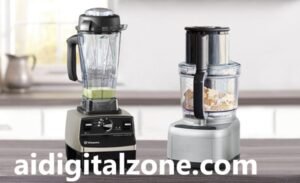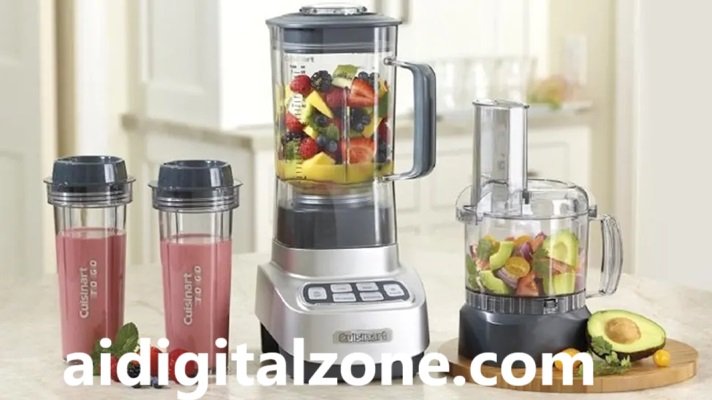Food Processor vs Blender: A Simple Guide
Food Processor vs Blender comes to kitchen appliances, two devices often come up in conversation. They are food processor and the blender. Both are versatile tools each design for specific tasks. Understanding the differences between the two can help you decide which one is best suited for your cooking needs. In this article explore the features and functions of a food processor and a blender highlighting what makes each one special.
What is a Food Processor?
A food processor is a kitchen tool designed to handle a wide variety of tasks. It is perfect for chopping, slicing, dicing, shredding, grating, and even kneading dough. It comes with a large bowl and several different attachments, such as blades, discs, and dough hooks, which allow it to perform various functions. Most food processors also have adjustable speed settings to give you more control over the texture and consistency of your ingredients.

Food processors excel at preparing vegetables, fruits, and nuts. They are ideal for tasks like chopping onions, making pesto, slicing vegetables for stir-fries, or preparing cookie dough. If you love meal prepping or baking, a food processor is a great tool to have in your kitchen.
What is a Blender?
A blender is designed primarily for liquids and foods that require pureeing, mixing, or liquefying. It typically features a tall, narrow container and a blade at the bottom that spins at high speeds to break down ingredients into smooth, liquid forms. Blenders are excellent for smoothies, soups, milkshakes, sauces, and even ice cream or frozen drinks.
Blenders come in various sizes, from personal size models to large countertop ones. Some have additional features like variable speed settings or pre-programmed functions for specific tasks. Blenders excel at turning solid ingredients into smooth liquids or pastes.
Key Differences Between a Food Processor and a Blender
Functionality and Purpose:
Food Processor: Ideal for chopping, slicing, shredding, dicing, and kneading. It’s focused on preparing solid food ingredients and can handle a wide range of textures and consistencies.
Blender: Best for blending, pureeing, and liquefying. It’s designed for liquids or soft foods and is great for making smooth blends from fruits, vegetables, and liquids.
Blades and Attachments:
Food Processor: Comes with various blades and discs that are easily interchangeable depending on the task. You might find slicing discs, grating discs, and dough blades, among others.
Blender: Typically has a single set of blades that are fixed at the bottom of the container. Some high-end models may offer multiple blade configurations, but the main focus is still blending.
Speed and Power:
Food Processor: Often offers adjustable speed settings, giving you more control over the texture of your food. You can pulse for rougher textures or use a slow speed for delicate tasks.
Blender: Operates at high speeds, with most models offering low and high-speed settings. The focus is on creating smooth, even blends quickly.
Capacity:
Food Processor: Food processors typically have larger bowls, making them perfect for preparing larger batches of food. Many offer at least a 10-cup capacity, ideal for family meals or meal prepping.
Blender: Blenders usually have smaller containers, making them great for drinks or small batches of soups or smoothies. Larger blenders are available for bigger batches as well.
Ease of Use:
Food Processor: While it might take a little time to set up different attachments, it’s a handy tool for a wide range of food preparation tasks.
Blender: Blenders are easy to use for simple tasks like making smoothies or soups. Just add your ingredients, secure the lid, and press a button.
Which One Should You Choose?
Both the food processor and the blender offer great benefits, depending on what you need in the kitchen. If you love making smoothies, soups, or milkshakes, a blender is a wonderful choice. It’s perfect for creating smooth, liquid-based dishes.
On the other hand, if you enjoy chopping, slicing, grating, or kneading dough, a food processor will be an excellent addition to your kitchen. It’s an all-in-one appliance for various food prep tasks.
Some people choose to have both appliances to cover all their needs. A food processor can handle solid ingredients and meal prep, while a blender can take care of drinks and purees. If you’re short on space, consider which tasks you do most often and choose accordingly.
Conclusion
A food processor and a blender are both valuable kitchen tools, each with its own strengths. A food processor is perfect for chopping, slicing, and dicing, while a blender is best for pureeing and mixing liquids. Consider the types of meals you prepare most often and what tasks you need help with in the kitchen. Choosing the right appliance will make cooking easier and more enjoyable.
Also Share: Fintechzoom.com Bitcoin Stock
